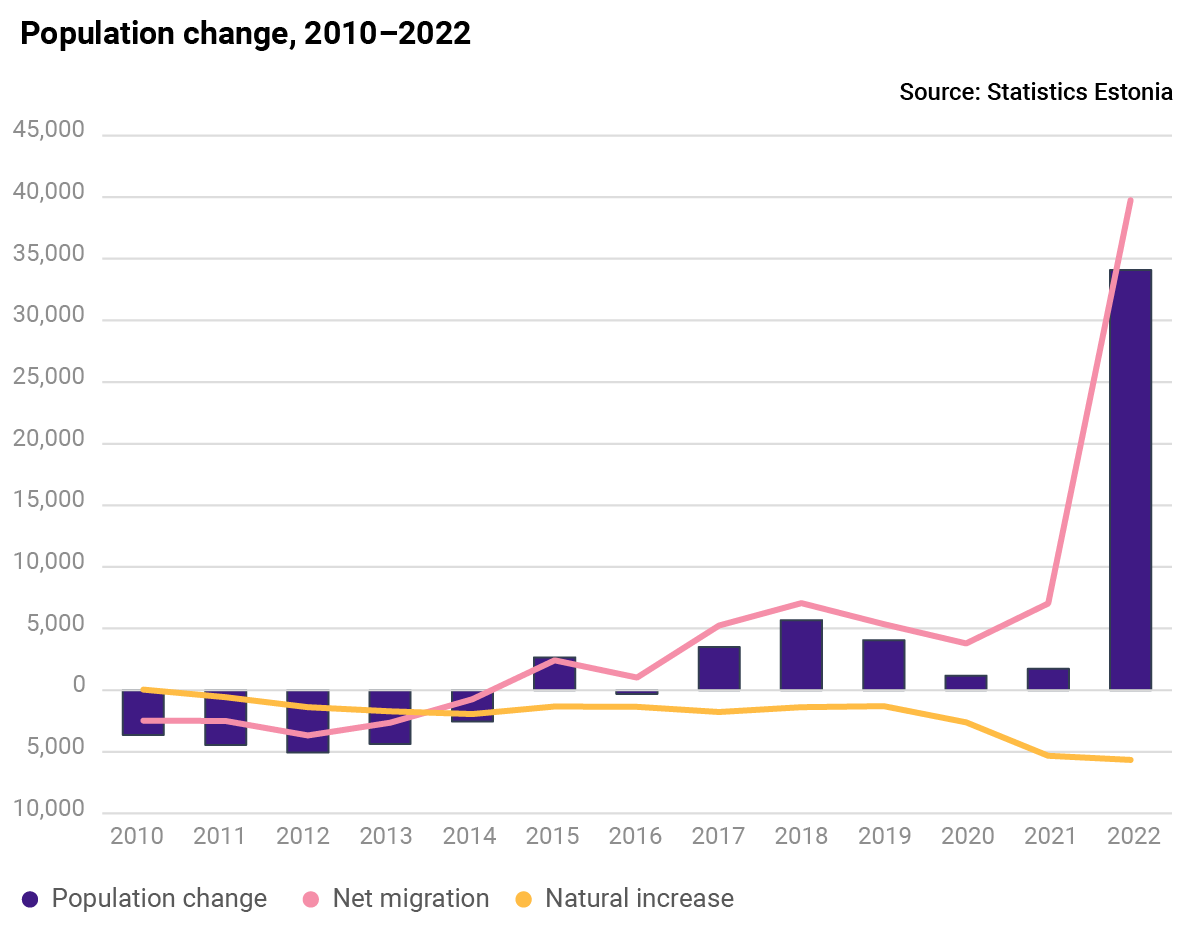Extraordinary year for population statistics – births at record low, migration at record high (corrected on 16.05.2023)
According to Statistics Estonia, 1,365,884 people live in Estonia as of 01.01.2023, which is 34,088 persons (2.6%) more than at the same time a year ago. In 2022, there were 11,646 births and 17,315 deaths in Estonia. 49,414 persons immigrated to Estonia and 9,657 persons emigrated from Estonia, therefore, immigration exceeded emigration fivefold.
The number marked in red was corrected in the news release.
Anet Müürsoo, Head of Population and Social Statistics Department of Statistics Estonia, said that 2022 was a remarkable year in terms of population statistics. “The population of Estonia increased by 34,088 persons or, figuratively speaking, by the number of people living in Võru county. Such growth is extraordinary. For comparison, in the two previous years, the population increased by around 1,700 persons (0.1%),” Müürsoo said.
The population was boosted by immigration, which was most affected last year by Ukrainians arriving in Estonia. People with Ukrainian citizenship accounted for 67% of immigrants, of whom 33,217 remained permanently in Estonia*.
2022 was also an exceptional year because of the low number of births. Never before have fewer than 12,000 births been recorded in Estonian population statistics, which date back to 1919. Last year, however, only 11,646 children were born. “The lowest birth rate in a century has probably been influenced by the coronavirus crisis, the war in Ukraine and the subsequent high price rises and cost of living, which in turn appear to have discouraged families from having children. The low birth rate is also affected by the fact that the nineties generation – which was smaller than previous generations – has entered the childbearing age,” explained Müürsoo.
Fewer first, second, and third children were born
11,646 children were born in 2022. “This is 12.3% less than in 2021. On average, there have been around 14,000 births a year since regaining independence. In terms of numbers, fewer first, second, and third children were born,” said Müürsoo. There was a slight increase in the share of first children (in 2021: 37.2%, in 2022: 39.8%), but a decrease of second (2021: 35.9%, 2022: 33.8%) and third children (2021: 18.8%, 2022: 18.1%) of all births. Last year, the average age of women giving birth was 31.2 years, compared with 28.9 for first-time mothers. Statistics Estonia will publish more detailed birth statistics for 2022 on May 31.
There were 17,315 deaths in 2022. “This is 1,272 fewer than in 2021, but it should be remembered that the number of deaths in 2021 was exceptionally high. Over the last ten years, the number of deaths per year has hovered between 15,000 and 16,000,” added Müürsoo.
Net migration of Estonian citizens was positive
Last year, 6,981 Estonian citizens arrived in the country and 5,352 left – arrivals outnumbered departures by 1,629. The highest number of citizens of other countries arriving in Estonia were those with Ukrainian citizenship (33,217), ten times more than a year ago. Immigration of Russian citizens is also on the rise, with 1,918 arrivals last year, 1,860 in 2021, and 1,417 in 2020.
The highest number of emigrants from Estonia still depart for Finland. 2,481 people left for that country (incl. 2,068 Estonian citizens), which is the lowest figure since 2018, and therefore Estonia's net migration to Finland was positive again after a couple of years. 2,744 people returned from Finland, 2,374 of them Estonian citizens.
“In total, 39,757 more people stayed in Estonia last year than left. Although 2022 will be marked by an exceptionally high number of immigrants, it is also worth noting that the number of emigrants was the lowest in recent years,” said Müürsoo.
* Data on Ukrainians
The data on registered migration published here cover persons who immigrated to Estonia in the last year and who, as of 1 January 2023, had a place of residence in Estonia according to the Population Register. Therefore, these figures do not include, for example, those Ukrainian refugees who are staying in Estonia but have not registered a place of residence here. In Estonia, data on Ukrainian war refugees are also collected by the Police and Border Guard Board, who publish the number of persons applying for temporary protection. Persons who have been granted temporary protection are included in the preliminary population figure only if they were residing in Estonia as at 1 January 2023 and had registered a place of residence in Estonia.
More detailed data have been published in the statistical database.
See also the population section on our website.
For further information:
Helen Maria Raadik
Media Relations Manager
Marketing and Dissemination Department
Statistics Estonia
Tel +372 625 9181
press [at] stat.ee
